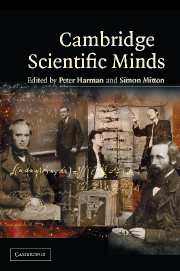Book contents
- Frontmatter
- Contents
- Foreword
- Introduction
- 1 William Gilbert
- 2 William Harvey
- 3 Isaac Newton: Creator of the Cambridge scientific tradition
- 4 William Whewell: A Cambridge historian and philosopher of science
- 5 Adam Sedgwick: A confident mind in turmoil
- 6 Charles Babbage: Science and reform
- 7 Charles Darwin
- 8 Stokes and Kelvin, Cambridge and Glasgow, light and heat
- 9 James Clerk Maxwell
- 10 The duo from Trinity: A.N. Whitehead and Bertrand Russell on the foundations of mathematics, 1895–1925
- 11 Thomson, Rutherford and atomic physics at the Cavendish
- 12 Hopkins and biochemistry
- 13 Charles Sherrington, E.D. Adrian, and Henry Dale: The Cambridge Physiological Laboratory and the physiology of the nervous system
- 14 Hardy and Littlewood
- 15 Arthur Stanley Eddington
- 16 Paul Dirac: A quantum genius
- 17 Alan Turing
- 18 Francis Crick and James Watson
- 19 Mary Cartwright
- 20 Joseph Needham
- 21 Molecular biology in Cambridge
- 22 The discovery of pulsars – prelude and aftermath
- 23 Stephen W. Hawking
8 - Stokes and Kelvin, Cambridge and Glasgow, light and heat
Published online by Cambridge University Press: 05 June 2014
- Frontmatter
- Contents
- Foreword
- Introduction
- 1 William Gilbert
- 2 William Harvey
- 3 Isaac Newton: Creator of the Cambridge scientific tradition
- 4 William Whewell: A Cambridge historian and philosopher of science
- 5 Adam Sedgwick: A confident mind in turmoil
- 6 Charles Babbage: Science and reform
- 7 Charles Darwin
- 8 Stokes and Kelvin, Cambridge and Glasgow, light and heat
- 9 James Clerk Maxwell
- 10 The duo from Trinity: A.N. Whitehead and Bertrand Russell on the foundations of mathematics, 1895–1925
- 11 Thomson, Rutherford and atomic physics at the Cavendish
- 12 Hopkins and biochemistry
- 13 Charles Sherrington, E.D. Adrian, and Henry Dale: The Cambridge Physiological Laboratory and the physiology of the nervous system
- 14 Hardy and Littlewood
- 15 Arthur Stanley Eddington
- 16 Paul Dirac: A quantum genius
- 17 Alan Turing
- 18 Francis Crick and James Watson
- 19 Mary Cartwright
- 20 Joseph Needham
- 21 Molecular biology in Cambridge
- 22 The discovery of pulsars – prelude and aftermath
- 23 Stephen W. Hawking
Summary
Victorian physics was largely Cambridge physics, and Cambridge physics was largely the creation of Sir George Gabriel Stokes (1819–1903) and William Thomson, Baron Kelvin of Largs (1824–1907). The Kelvin temperature scale, Stokes' parameters for polarised light, Stokes' law for a sphere moving through a viscous fluid: the language of today's physics quietly echoes yesterday's greatness. This chapter tries to recapture some of that greatness by placing the intertwined careers of Stokes and Kelvin within the broader story of Victorian physics and Victorian Cambridge University. Their collaboration and influence is symbolised by the fact that what is known as Stokes' theorem was suggested in a letter from Kelvin to Stokes and then set by Stokes as a question in a Cambridge examination taken by James Clerk Maxwell, generally acknowledged as the premier physicist of the century.
The careers of the two had close similarities. Both succeeded in Cambridge's Mathematical Tripos in the 1840s and obtained professorships that they would hold for more than five decades. Early research gained both election as fellows of the Royal Society of London in 1851. Thomson received a knighthood in 1867, Stokes was created a baronet in 1889, and Thomson was raised to the peerage in 1892, becoming Lord Kelvin. As elder statesmen of Victorian science, they occupied the presidency of the Royal Society for a decade, Stokes from 1885 to 1890 and Thomson from 1890 to 1895.
- Type
- Chapter
- Information
- Cambridge Scientific Minds , pp. 107 - 122Publisher: Cambridge University PressPrint publication year: 2002



